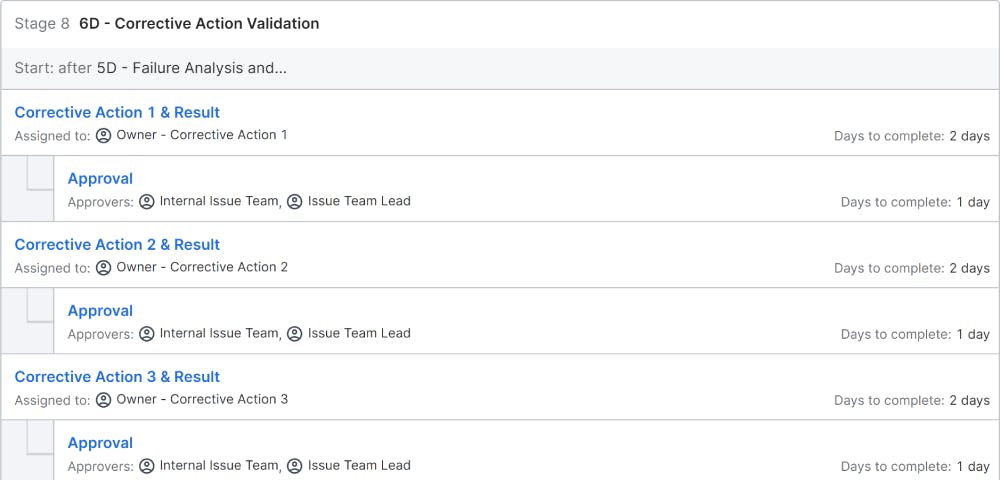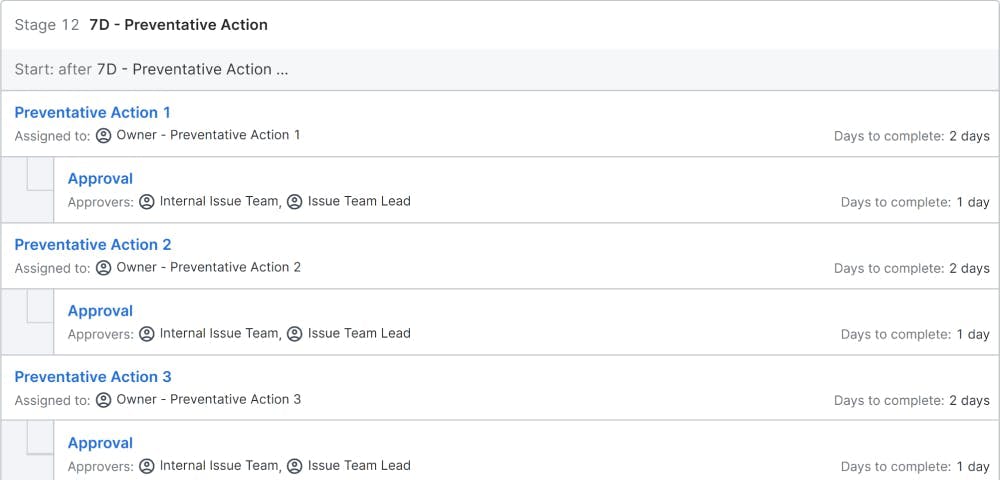8D Problem Solving Process
Problem solving processes for product and manufacturing companies have many names 8D, 5C, Issue Management, Corrective Action, etc., however, they all address the key goal of identifying, managing, correcting, and preventing issues affecting internal and external stakeholders. A favorite in the industry is the 8D Problem Solving Process (8D), because it is a team-oriented and structured problem-solving methodology that emphasizes the idea that problems should not be repeated but fixed permanently. This process focuses on the origin of the problem by determining root causes and establishing permanent corrective and preventive actions.
Additionally, what makes the 8D process widely used is the fact that other problem solving processes such as the 5 Whys, 5C, Process Flow Charting, Is/Is Not Analysis, Fishbone Diagram, Process Variables Mapping, Comparative Analysis, Root Cause Verification, and Process Control Plans are an integral part of the overall 8D process. This allows the process to be easily adapted and updated to specific needs.
The U.S. government first standardized the 8D Problem Solving Process during the Second World War. It was later improved and popularized by the Ford Motor Company in the early ‘90s and has become an integral process within the largest and most successful companies to date.
STAGES

0D - Check Historical 8D Issues
The goal of this stage is to look through your historical problem solving archive for similar issues to be used as a basis and framework to help accelerate a path to issue resolution. If Regrello is used for this process, the data will automatically be archived and searchable.
1D - Team Formation
Assign an Issue Team Lead and an Internal Issue Team, responsible for driving the issue to resolution. The Issue Team Lead should be an internal user that can drive cross functional action to address the issue. The Internal Issue Team should be a small internal and/or external group with the process and/or product knowledge, allocated time, authority, and skills in the required technical disciplines to solve the issue and implement corrective / preventative actions.
2D - Issue Description & Problem Statement
The team should collect details about the problem, typically a preliminary Failure Analysis (FA) and/or Root Cause Analysis to help get a complete understanding of the problem. The team then develops a clear problem statement and problem description by identifying “what is wrong with what” and detailing the problem in quantifiable terms.
3D - Containment Plan
This is an optional stage depending on the issue that is getting resolved. This stage defines, verifies and implements containment action to isolate the effects of the issue from any internal and/or external customer until permanent corrective (preventive) actions are implemented. Key steps in this stage might involve actions like isolating the items affected, stopping production, and replacing defective parts. This stage’s goal is to prevent the issue from getting worse and reaching the market and customers.
4D - Failure Analysis and Root Cause Analysis
This stage utilizes Failure Analysis and Root Cause Analysis to identify, isolate, and verify the failure and root cause of the issue that could have been detected and contained but was not. Teams should ensure they have enough or gather more data to learn more about the issue and its possible causes.
The goal of the Failure Analysis is to determine the mechanism and the cause of the failure, essentially how and why the product failed. This will lead to a Root Cause Analysis that will be used in conjunction with the Failure Analysis to identify the key equipment failures, process failures, environmental factors, or human errors that will help identify the Corrective Actions that need to be taken to fix the issue. The outcome of this stage should have a defined test plan with test owners who execute and verify the test.
5D - Corrective Actions
This stage looks at the Failure Analysis and Root Cause results to determine the key Root Causes and the potential Corrective Actions that will fix the issue. These Corrective Actions need to address the root cause and failure points in the process. Additionally, Corrective Actions need to be tracked and verified to ensure that the solution is successful and does not cause any other issues. Corrective Actions can be short-term fixes until longer-term Preventative Actions can be implemented. The outcome of this stage should have a defined Corrective Action Test Plan with test owners who execute and verify the test.
6D - Corrective Action Validation
This stage is where the team executes the Corrective Action Test Plan and validates if the Corrective Actions are effective in addressing the root cause and failure points in the process as well as ensuring the fix is not causing other issues. The team will then deliver and review the results of the Corrective Actions to determine if the issue is addressed. If the issue is not completely addressed, the team can repeat stages “4D - Failure Analysis and Root Cause Analysis” and “5D - Corrective Actions” until a solution is found.
7D - Preventative Actions
This stage looks at the Corrective Action results to determine Preventative Actions to identify a potential long term solution that will not allow the issue or similar issues from occurring. These Preventative Actions may make changes in the system, software, people, products, and or upstream or downstream processes etc.
The outcome of this stage should have a defined Preventative Action Plan with owners who implement and verify the Preventative Actions. The team needs to monitor the long-term results of these Preventative Actions to ensure its effectiveness.
8D - Final Review & Lessons Learned
This stage is where the team delivers their Lessons Learned from the 8D issue process, conducts a Final Review, and has a future check in on the effectiveness of the implemented Corrective and Preventative Actions.
Lessons Learned are the documented positive and negative experiences or lessons learned while working through an issue. These Lessons Learned are important to the overall 8D process as they become a database to capture learnings from one issue and preserve them for future issues. They allow the team to understand efficiencies from previous 8D solutions and to avoid repeating mistakes or problems.
The Final Review should include all relevant stakeholders and their leaders if necessary. In this Final Review, teams should discuss if they should integrate the findings and lessons learned into the 8D Problem Solving Process.
The Corrective & Preventative Action Check In confirms that the Corrective and/or Preventative Actions implemented are continuing to fix the issues as expected and identify opportunities to improve them.
WHO SHOULD USE THIS PROCESS
Like many of Regrello’s Compendiums, the 8D Problem Solving Process is most applicable for mid to large size companies that develop or manufacture products, as the structure, vocabulary, and author’s experience lie in that field. It can be, with modification, applied to other areas. Smaller entities can definitely use what’s presented, and it should help avoid common pitfalls, however the documentation expected and roles outlined may be beyond Kickstarter startups or first-product operations. Similarly, global entities with established processes may already have much of what’s outlined incorporated within their existing structure. While they too can usually benefit from thinking holistically about the process, their main benefit from Regrellos’ compendiums will come from the high-level visibility provided by moving communication out of email and into a specific project-focused workflow, enabling reporting and cross-product learning.
Otherwise, this guide should be of benefit to everyone who develops or manufactures products, be it in-house or in collaboration with a supplier, a more rigid Contract Manufacturer (CM), Electronic Manufacturing Services Provider (EMS), or Original Equipment Manufacturer (OEM) structure, or a more-closely constructed partnership.
WHY USE THIS PROCESS
The main benefits of this 8D Compendium lie in the standardized and automated structure of the blueprint. Breaking down the process into clearly defined stages that allow flexibility to solve any problem as well as give a historical library of the challenges, issues, and risks within production while also enabling personnel to get up to speed on projects more quickly. In addition, by documenting the issues, root cause, and solutions, past projects become learning material for new employees, allowing lessons learned to be easily accessible and help guide future decisions.
Implementing a standard, methodical, and referenceable Problem Solving Process drastically reduces risk, provides visibility, and accelerates the issue resolution by providing a clear method and guide to solve inherently variable problems. Delays in addressing and fixing issues result in delivery delays, wasted components and labor dollars, and negative relationships with your partners. Improving the control, visibility and reliability of this process is of primary importance to leadership in any product or manufacturing company.

















